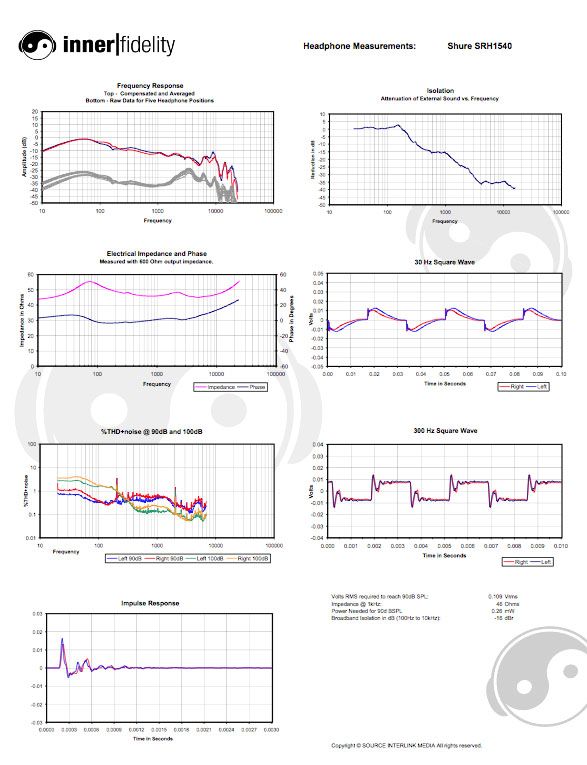| Columns Retired Columns & Blogs |
The Cool, Comfy, and Competent Shure SRH1540 Measurements
Click on graphs image to download .pdf for closer inspection.
Raw frequency response plot shows a headphone that changes little with position change on the head. Raw response curves are eerily similar to the Harman target response; of particular note is the minimal amount of noise in the response above 4kHz. Compensated plot shows a fairly linear response between 50Hz and 5kHz, but the 10kHz peak above the best fit straight line through the mid-range typically suggests to me a headphone that will be perceived as somewhat bright. In listening at reference level these cans did seem a bit bright.
The bass falls off moderately below 50Hz due to going through the primary driver resonance, which can be seen on the impedance plot. As the driver goes through resonance phase changes are experienced, which can in turn cause a looser sounding bass. The sway back of the 30Hz square wave is evidence of this.
300Hz square wave has quite good shape but for the slightly too deep dip after the initial edge, and some fairly mild subsequent noise. I like this response as I believe a very clean initial transient peak with little thereafter provides good edges to give your ears the ability to localize better, and indeed, the SRH1540 does a very good job of producing a spacious image for a closed headphone.
The impulse response gives a clearer image of the ability to produce clean transients, and here we again see a very clean initial spike. Subsequent blips and noise is a bit high, and it seems to me possible that here is where the headphone just might loose enough resolution to prevent it from being classed with the upper-echelon of high-end headphones. Still, the noise dies down fairly quickly; I would call this a pretty good, but not great result.
Distortion plots show a fairly low distortion headphone with problems keeping a good enough seal for bass response. 90dB plot is okay, but the 100dB plot shows a headphone that has a hard time handling lots of power down low. This result will also degrade the quality of bass performance. Listening tests did reveal some marked looseness of the bass especially at higher listening levels.
Isolation plot shows that these cans isolate fairly well. in fact, isolation is slightly better than the Focal Spirit Pro or NAD VISO HP50 in the 150Hz to 500Hz region. above 4kHz the isolation flattens out and is less than the other two cans. I have the idea that having a little high frequency sound leak in from the outside helps develop a sense of spaciousness in headphones. This slightly leaky high-frequency seal of the 1540 might contribute to the sense of space when listening.
With 109 mVrms to achieve 90dBspl at the ear these cans will likely not be driven to loud listening levels with portable devices, but should be okay for normal listening levels.
- Log in or register to post comments





































